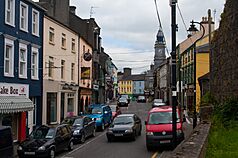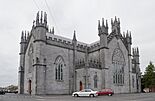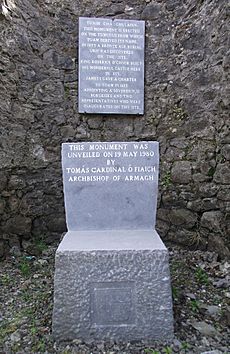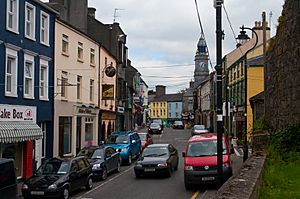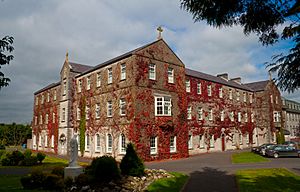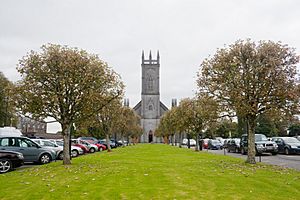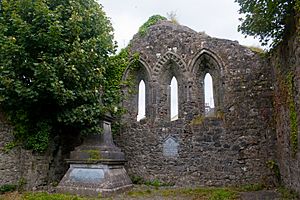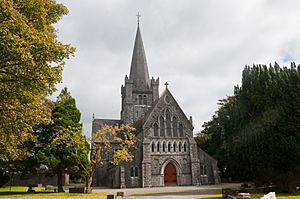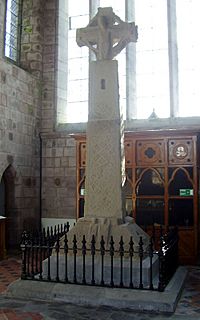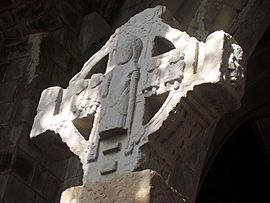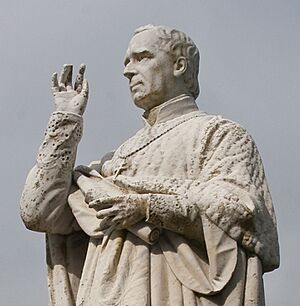Tuam facts for kids
Quick facts for kids
Tuam
Tuaim (Irish)
|
||
|---|---|---|
|
Town
|
||
|
From the top, Tuam High Street, Cathedral of the Assumption, Tuam Town Hall
|
||
|
||
| Motto(s):
Irish: Tuath Thuama go Buan
"Long Live the People of Tuam" |
||
| Country | Ireland | |
| Province | Connacht | |
| County | County Galway | |
| Municipal District | Tuam | |
| Dáil constituency | Galway East | |
| Area | ||
| • Total | 6.5 km2 (2.5 sq mi) | |
| Elevation | 44 m (144 ft) | |
| Population
(2022):
|
||
| • Total | 9,647 | |
| • Density | 1,484/km2 (3,844/sq mi) | |
| Eircode routing key |
H54
|
|
| Telephone area code | +353(0)93 | |
| Irish Grid Reference | M436521 | |
| Historical population | ||
|---|---|---|
| Year | Pop. | ±% |
| 1821 | 4,571 | — |
| 1831 | 6,883 | +50.6% |
| 1841 | 6,034 | −12.3% |
| 1851 | 4,929 | −18.3% |
| 1861 | 4,563 | −7.4% |
| 1871 | 4,223 | −7.5% |
| 1881 | 3,567 | −15.5% |
| 1891 | 3,012 | −15.6% |
| 1901 | 2,896 | −3.9% |
| 1911 | 2,980 | +2.9% |
| 1926 | 3,293 | +10.5% |
| 1936 | 4,181 | +27.0% |
| 1946 | 3,868 | −7.5% |
| 1951 | 4,010 | +3.7% |
| 1956 | 4,789 | +19.4% |
| 1961 | 4,732 | −1.2% |
| 1966 | 4,742 | +0.2% |
| 1971 | 4,952 | +4.4% |
| 1981 | 6,093 | +23.0% |
| 1986 | 6,039 | −0.9% |
| 1991 | 5,540 | −8.3% |
| 1996 | 5,627 | +1.6% |
| 2002 | 6,027 | +7.1% |
| 2006 | 6,885 | +14.2% |
| 2011 | 8,242 | +19.7% |
| 2016 | 8,767 | +6.4% |
| 2022 | 9,647 | +10.0% |
Tuam (pronounced 'TCHOOM') is a town in Ireland. It is the second-largest town in County Galway. Tuam is located west of the midlands of Ireland. It is about 35 kilometers (22 miles) north of Galway city.
People have lived in the Tuam area since the Bronze Age. Its history as a town goes back to the sixth century. Tuam became very important in the 11th and 12th centuries. It was a key place for both politics and religion in Ireland. The town's design, with its market and square, shows how important trade was.
The red cross on Tuam's coat of arms shows its importance as a religious center. The green parts on the sides represent the two hills that gave Tuam its old name, Tuaim Dhá Ghualainn. The two crowns remind us of the High Kings, Tairrdelbach and Ruaidrí, who ruled from Tuam. The broken chariot wheel is a symbol from the story of how the town's monastery was founded. This happened when St Jarlath's chariot wheel broke. The town's motto, Tuath Thuama go Buan, means "Long Live the People of Tuam".
Contents
History of Tuam
People first settled in Tuam during the Bronze Age. A burial ground from around 1500 B.C. was found near Shop Street. The name Tuam comes from a word meaning 'mound' or 'burial-place'. The town's old name, Tuaim Dá Ghualann, means "the burial mound of two shoulders". This likely refers to the high ground on both sides of the River Nanny.
Records from the early sixth century mention a monk named Jarlath. He was part of a religious group near Tuam. A story says that another saint, Brendan, told Jarlath to build a new chariot. Brendan said, "wherever the two hind shafts of the chariot will break, there will be thy resurrection." Jarlath's chariot wheel broke in Tuam. So, he built a monastery there, called the School of Tuam. Towns in Ireland often grew up around religious sites. Tuam did too, and the broken chariot wheel became its symbol.
In 1049, Aedh O'Connor won a battle and became king of Connacht. He built a castle in Tuam and made it his main base. This made Tuam a very important town.
In the 12th century, Tuam became the center of power in the province. This was during the 50-year rule of Tairrdelbach Ua Conchobair (1106–1156). He was the High King of Ireland and made Tuam his main seat of power.
Around 1140, Tairrdelach started an Augustinian priory in Tuam. In 1152, Tuam became an Archbishopric, a major church center. Áed Ua hOissín became the first Archbishop.
Tairrdelbach Ua Conchobair supported the Irish Church. Because of him, Tuam became home to beautiful 12th-century Celtic art, like the Cross of Cong. His son, Ruaidrí Ua Conchobair, was the last native High King of Ireland. In 1164, Ruaidrí built a "wonderful castle" in Tuam. It was the first stone castle built by Irish people. A small part of this castle still stands today. After the first Cathedral was destroyed in 1184, Ruaidrí left Tuam. The town became smaller until the early 17th century when it started to grow again.
Tuam has always been an important place for trade. Fairs and markets were a big part of business. One fair dates back to 1252.
In July 1920, the Tuam Town Hall was damaged. This happened after two police officers were killed in an ambush nearby.
The Bon Secours Mother and Baby Home operated in Tuam from 1925 to 1961. It was a home for unmarried mothers and their children. It was run by the Bon Secours nuns. Before this, the building was a workhouse for the poor. Between 2016 and 2017, investigations found human remains at the site. These remains were of children, from unborn babies to toddlers. Most were from the 1950s. The discovery led to an ongoing investigation into the site.
In 1980, a large monument called the "Chair of Tuam" was revealed. The High Cross of Tuam was moved back to St Mary's Cathedral in the 1980s.
Local Government
In 1613, Tuam received a special royal charter. This allowed the town to send two representatives to the Irish Parliament until 1801. The town was designed as a market town. All its streets meet at the central square. The charter also created a local council with a leader and 12 members. The leader was sworn in at the "Chair of Tuam," which is believed to be in the old castle tower. The local council was changed in 2014. Now, Tuam elects 7 councilors to the Galway County Council.
Weather in Tuam
| Climate data for Tuam (Airglooney) (1981–2010) | |||||||||||||
|---|---|---|---|---|---|---|---|---|---|---|---|---|---|
| Month | Jan | Feb | Mar | Apr | May | Jun | Jul | Aug | Sep | Oct | Nov | Dec | Year |
| Mean daily maximum °C (°F) | 8.7 (47.7) |
9.0 (48.2) |
10.7 (51.3) |
13.0 (55.4) |
15.7 (60.3) |
18.3 (64.9) |
19.4 (66.9) |
19.3 (66.7) |
17.3 (63.1) |
14.1 (57.4) |
11.4 (52.5) |
8.9 (48.0) |
13.8 (56.9) |
| Daily mean °C (°F) | 5.2 (41.4) |
5.5 (41.9) |
6.9 (44.4) |
8.4 (47.1) |
10.9 (51.6) |
13.4 (56.1) |
15.1 (59.2) |
14.9 (58.8) |
12.9 (55.2) |
10.1 (50.2) |
7.8 (46.0) |
5.5 (41.9) |
9.7 (49.5) |
| Mean daily minimum °C (°F) | 1.7 (35.1) |
2.0 (35.6) |
3.1 (37.6) |
3.9 (39.0) |
6.1 (43.0) |
8.5 (47.3) |
10.8 (51.4) |
10.6 (51.1) |
8.6 (47.5) |
6.0 (42.8) |
4.2 (39.6) |
2.0 (35.6) |
5.6 (42.1) |
| Mean monthly sunshine hours | 42.70 | 61.82 | 93.31 | 142.80 | 169.26 | 144.00 | 126.79 | 124.93 | 104.70 | 86.18 | 52.80 | 33.79 | 1,183.08 |
| Source: Met Éireann | |||||||||||||
Getting Around Tuam
Tuam is connected by important roads like the N17 and the N83. A new bypass for the N17 was opened in 2017. This helps cars avoid traffic in the town. The bypass also has a bridge over the old railway lines, so the train line could be used again in the future.
The Tuam railway station is on a railway line that is not currently used for passengers. This line was once very busy, especially for carrying sugar beets to a factory. The railway line was even used in the movie The Quiet Man. Tuam is also served by many Bus Éireann routes.
Schools in Tuam
Tuam has several secondary schools. These include St Jarlath's College, Archbishop McHale College, Presentation College Currylea, and St Bridget's Secondary School. In September 2023, Presentation College and St. Bridget's joined together to form High Cross College.
There are also five main primary schools in Tuam. These are the Mercy Convent, the Presentation Convent, St Patrick's Primary School, the Educate Together National School, and Gaelscoil Iarfhlatha (an Irish language primary school).
Economy of Tuam
Tuam has several large companies that provide jobs. The biggest employer is Valeo Vision Systems, which employs over 1000 people.
Religion in Tuam
Tuam is home to two cathedrals. One is the Cathedral of the Assumption of the Blessed Virgin Mary, Tuam, which is for the Roman Catholic Archdiocese of Tuam. The other is St Mary's Cathedral, which belongs to the Church of Ireland. The town's special saint is Saint Jarlath.
Sports in Tuam
Gaelic Games
Tuam Stars is the local Gaelic football team, started in 1888. They are one of Galway's most successful clubs. From 1953 to 1960, Tuam Stars won seven county championships in a row. St Jarlath's College in Tuam has won the Hogan Cup (a national championship for secondary schools) a record 12 times. There is also another Gaelic football club called Cortoon Shamrocks.
Tuam Stadium, also known as St Jarlath's Park, opened in 1950. It is called "the home of Galway football" and has hosted many important games. There are plans to redevelop the stadium with a new stand and facilities.
Soccer
Tuam has two soccer clubs. Tuam Celtic A.F.C. was founded in 1974. Dynamo Blues was founded in 1978.
Rugby
Tuam Rugby Football Club is a rugby union club. It has adult teams, women's teams, and youth teams for both boys and girls. The club has grown a lot since it started in 1969.
Golf
Tuam Golf Club started in 1904. It moved to a new location in 1937. Famous Irish golfer Christy O'Connor Snr was the club professional in 1948. The club now has an 18-hole course.
Athletics
Tuam Athletics Club is a busy club with training sessions and events for both children and adults. In 2020, Tuam hosted the Rob Heffernan Academy Grand Final, a race walking event for young athletes.
Gymnastics
Tuam All Star Gymnastics Club offers classes. In 2010, the club reached the semi-finals of the All Ireland Talent Show.
Swimming
Tuam Swimming Club has been promoting swimming since 1950. The club runs its season from September to June each year.
Culture and Arts
Arts and Music
The Marian Choral Society started in 1974. They perform musicals every October.
Earwig! Tuam Community Arts Group began in 2003. They help local artists and organize an arts festival. This festival includes visual arts, theater, music, and workshops for children. Earwig! also takes part in the St Patrick's Day parade.
Tuam is known for its music. While The Saw Doctors are a famous band from the town, in the 1960s, Tuam was called 'The Showband Capital of Ireland'. Many showbands were based there. A CD called Songs from the Broken Wheel was released in 2009, featuring over 50 songs by musicians from Tuam. Tuam is also mentioned in the popular Irish folk song "The Rocky Road to Dublin".
Old Tuam Society
The Old Tuam Society was founded in 1942. Its goal is to keep records of the town's past and share this knowledge. The society publishes an annual journal called JOTS.
Market Day
The Tuam market was brought back in 2006. It is now held on the last Saturday of every month at the plaza in front of Tuam Shopping Centre.
Local News
The Tuam Herald is a weekly local newspaper. It was started in 1837 and serves Tuam and the surrounding areas. It is the oldest newspaper in County Galway.
Public Library
Tuam Library is on High Street. It has books on general topics and local history. You can also find copies of the Tuam Herald and old census records there. The library offers free internet and Wi-Fi.
International Connections
Twin Towns
Tuam is twinned with Straubing in Germany. This means the two towns have a special friendship and connection.
Interesting Places to Visit
- Temple Jarlath at High Street is where the first monastery in Tuam was built by St Jarlath around 526–527 AD. The ruins include a 13th-century church with a beautiful east window.
- The Mill Museum is off Shop Street. This old water wheel mill was used until 1964. It is the only preserved corn mill in the West of Ireland. The museum shows how the mill worked and has a tourist information office.
- Cathedral of the Assumption is the Roman Catholic Cathedral in Tuam.
- St Mary's Cathedral is the Church of Ireland Cathedral. It was built between 1861 and 1878. It includes parts of older buildings, like a 12th-century arch.
- Castlehacket is a 13th-century tower house near Tuam. It was once home to the Hacket and Kirwan families. Parts of the 1969 movie Alfred the Great were filmed nearby.
- Feartagar Castle is a Burke family castle located 8 kilometers (5 miles) northwest of Tuam.
The High Crosses of Tuam
The High Cross of Tuam was put up in 1152. It might have been to celebrate the first Archbishop of Tuam, Archbishop Áed Ua hOissín. It is said to have been the tallest High Cross in Ireland. The Cross was originally near the first Cathedral in Tuam.
After the first Cathedral was destroyed by fire in 1184, the High Cross was taken apart. Later, pieces of it were found and put back together. It even includes a piece from another High Cross. For a long time, the Cross was in the town square.
In 1852, the Cross was taken to Dublin for a big exhibition. When it was time to bring it back, there was a disagreement about who owned it. Finally, it was decided to put the Cross halfway between the two Cathedrals. This way, it could be seen from all the main streets.
By the late 1980s, the Cross was getting damaged by weather and pollution. Experts worried about traffic nearby. In 1992, the Cross was moved from the Square. After being cleaned and repaired, the High Cross was placed inside St Mary's Cathedral, where it is now. St Mary's Cathedral also has a part of a third Cross. These High Crosses likely marked the edges of the old monastery area in Tuam.
Famous People from Tuam
Many notable people have connections to Tuam:
- Amergin of Maigh Seóla (around 550) – father of Saint Finbar.
- Blaze X – a punk band.
- Augustus Nicholas Burke (1838–1891) – an artist.
- Catherine Corless (born 1954) – a local historian and activist.
- Mike Cooley (1934–2020) – a trade union activist.
- Paul Cunniffe (1961–2001) – a singer-songwriter and musician.
- Raymond Deane (born 1953) – a classical composer.
- Richard W. "Dick" Dowling – fought in the U.S. Civil War.
- Jarlath Fallon (born 1973) – a Gaelic footballer.
- John Fury - a boxer and father of Tyson Fury.
- Áed Ua hOissín – the first Archbishop of Tuam.
- Colm Keaveney (born 1971) – a politician.
- John MacHale – an Archbishop of Tuam.
- Peter Maher – a heavyweight champion boxer.
- Stephen Moore – an Australian International rugby player.
- Tom Murphy – a playwright.
- Brendan Murray – a singer, member of the band HomeTown and Irish 2017 Eurovision entrant.
- Seán Purcell – a Gaelic footballer.
- The Saw Doctors – a famous band.
- Frank Stockwell – a Gaelic footballer.
Places Named After Tuam
- Tuam Street in Christchurch, New Zealand.
- Tuam Streets in Concord, Sydney, and Victoria Park, Perth, Australia.
- Tuam Street in Houston, Texas, US, named after Richard W. "Dick" Dowling from Tuam.
- Tuamstraße (Tuam Street) in Straubing, Germany, named because Tuam and Straubing are twin towns.
- Tuam Road in Plumstead, London, England.
See also


